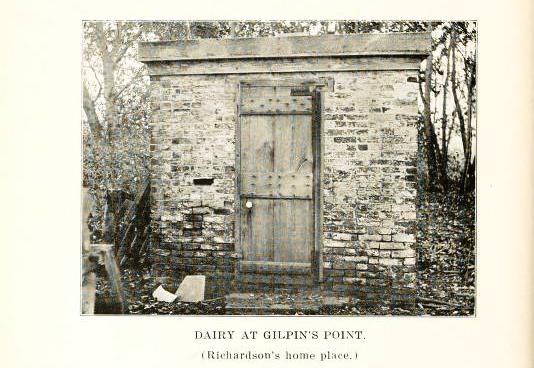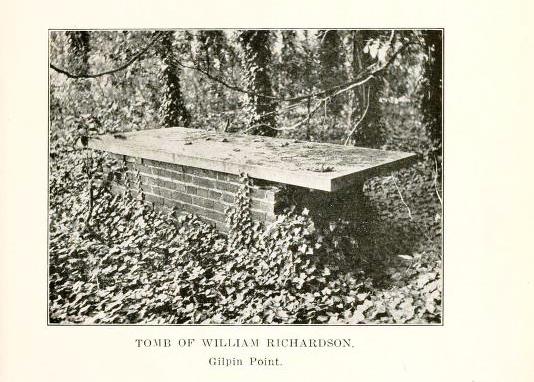The History of Caroline County, Maryland, From Its Beginning
Colonel William Richardson
(1735-1825)

William Richardson, born 1735, was the son
of William and Ann Webb
Richardson, Quakers of Talbot County, but in early manhood moved to
Dorchester, where he owned large tracts of land. It was while he
was a member of the General Assembly from that county in 1773 that he
presented a bill which provided for forming Caroline from Dorchester and
Queen Anne's counties. The bill was passed and in March 1774
Caroline County was organized with Richardson as one of its original
commissioners.
He became a member of the Maryland
Convention of Delegates from Caroline at the January session of 1776,
which position he resigned in August of the same year upon being
commissioned Colonel of the Eastern Shore Battalion of the Maryland
Flying Camp. In this position Colonel Richardson became
a man of Continental importance, serving his country in this way for
over three years. His regiment first saw active service at Harlem
Heights, and so well did they acquit themselves that General
Washington commended their bravery.
When the men of the flying camp were
discharged (Dec. 1776) Richardson continued
as colonel in a battalion of re-enlisted men known as the "Fifth
Regiment of the Maryland Line." From that time until the close of
the war, much of his activity seems to have been confined to the lower
section of the Eastern Shore and Delaware. One example of this
service is given here. During the month of February 1777, Colonel
Richardson was sent with such of the militia and his
own regulars as he thought necessary to assist in suppressing the tories
in Somerset and Worcester counties. Something of the success of
his expedition may be gathered from the following letter from the
Council of Safety to Colonel Richardson:
The same year he was appointed clerk of the county court, but soon found his other duties so pressing that he deputized John Baker to act for him. When the British made their attack upon Philadelphia in December of 1777, Colonel Richardson was commissioned to remove the Continental Treasury to Baltimore. This consisted of such notes and specie as the Continental Congress had on hand for supplying the needs of the provinces.Annapolis, Feb. 19, 1777
Sir,
We have the honor of transmitting to you thanks of the General Assembly of this state for your spirited conduct in marching your Battalion of Militia in order to assist General Hooper in quelling the insurrection in Somerset and Worcester Counties.
With the greatest respect and regards,
Sir, your most Obedient Servant,
The Council of Safety.
In '78 he was a member of the convention to ratify the Constitution of the United States. From 1789-1793 he was Presidential elector in the college that elected Washington president. Another prominent position in his later life was the treasurer-ship of the Eastern Shore, an office which he held at the time of his death in July 1825.
Although not a man of great wealth, Richardson lived in such luxury as was the custom in his generation. Upon his plantation, known as Gilpin Point, situated on the Choptank River, stood his family mansion, store house, granary, blacksmith and carpenter shops, and other outbuildings. Like all such estates at that time, Gilpin Point resembled a little village in itself. In times of peace gay crowds assembled there, for Richardson was famous for his hospitality; in times of war, supplies were sent there from Annapolis and Baltimore to be distributed among the various companies of the Colonel's regiment.
While a young man, William Richardson married Elizabeth Green. Their family consisted of six children, namely William, Thomas, Daniel Peter, Joseph, Mary and Ann Webb. Mrs. Richardson, Thomas and Mary, who had married James Price of Easton, died before the Colonel. The other daughter, Ann Webb, became the wife of William Potter of Potter's Landing.
In the days before the Revolution, Richardson owned part interest in a sloop, "The Omega," which is said to have carried cargoes of parched corn to the West Indies. On return trips quantities of coral stone were brought as ballast and from these stones his slaves built a wall surrounding his home.
Along with considerable evidence as to Col. Richardson's being interested in ocean shipping and trading, the following story taken from the life of Commodore Joshua Barney may be of interest here:
| Capt. Barney noted for his privateering during the Revolutionary War had been captured, taken to England and lodged in Mill Prison at Plymouth in the year 1781. Upon escaping, he managed to get to the home of a friend, a minister, in the town and there met two farmer friends, Col. Wm. Richardson and Dr. Hindman of the Eastern Shore of Maryland. These men had gone over on a merchant vessel and upon its being captured, were waiting for an opportunity to return to America. Richardson and Hindman engaged in fishing smack and Barney agreed to carry them to France where they could easily find a way home. Changing his uniform for a fisherman's suit, Barney placed his two friends in the cabin of the boat and set sail across the English Channel. After being out a few hours, the boat was overhauled by an English guard and taken back to Plymouth over a boisterous sea which for several hours had kept our Col. Richardson a prisoner in the hull of the boat and suffering from seasickness. Upon reaching Plymouth, however, Richardson and Hindman who had committed no wrong were released while Barney was again put in prison. |
Parts of the old coral wall, a brick dairy, and the fast crumbling tomb of Caroline's most illustrious soldier are all that now remain at Gilpin Point to remind present Carolineans of her original sponsor.
